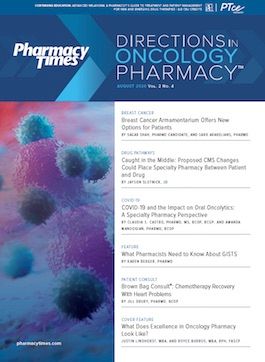Publication
Article
Pharmacy Practice in Focus: Oncology
Caught in the Middle: Proposed CMS Changes Could Place Specialty Pharmacy Between Patient and Drug
Author(s):
Patient assistance programs are often the difference between accessing the drug and increasing abandonment rate.
Every day thousands of critically ill patients receive specialty prescriptions. Many of these commercially insured patients rely on manufacturer-sponsored patient assistance programs (PAPs) for help in paying for their lifesaving drugs. These programs are often the difference between accessing the drug and increasing the abandonment rate. However, based on final rules and proposed changes from the Centers for Medicare & Medicaid Services (CMS), dramatic changes may be on the horizon that will affect the availability of these crucial safety net programs.
Earlier this year, CMS permitted self-insured and many other types of health insurance plans to implement antiaccumulator programs. Established by pharmacy benefit managers (PBMs), these programs exclude the value of co-pay assistance from accruing toward patient deductibles and annual cost-sharing limits. CMS states that the PBMs take the position that “manufacturer-sponsored assistance programs steer consumers towards more expensive medications when there may be more cost saving options available to health plans,” and as a result, they force (“encourage”) health plans to apply manufacturer PAPs to the plan’s benefit instead of the patients’.1 These arrangements are purportedly justified by PBMs as a cost control measure. CMS accepted the PBMs’ position and finalized regulations permitting these programs.2 In doing so, it seems that CMS may not have considered patient, physician, or specialty pharmacist statements that, for the overwhelming majority of the time, no alternative drug is available and that the PBM is shifting the expense back to the patient or the manufacturer.
Adding insult to this injury is CMS’ failure to require that the health plan disclose the existence of these programs. There is no transparency to the patient, the physician, the specialty pharmacist, or the manufacturer. In other words, in choosing a health plan, the patient has no idea that this program exists until, of course, it is too late.
CMS was not done with its assault on PAPs. Recently, CMS proposed significant changes to the treatment of manufacturer assistance programs and their current exclusion from Medicaid price reporting obligations. Currently, manufacturers are permitted to make reasonable assumptions3 that discounts and other assistance to eligible patients through their PAPs are generally excludable from the Medicaid price reporting requirements because they meet established exemptions that apply to such programs when the full value of the discount or coupon is passed on to the patient. In essence, manufacturers intend for these programs to fully benefit the patient.
CMS, however, questions the availability of this exemption for antiaccumulator programs because the financial benefit of the patient assistance does not accumulate to the patient but rather the health plan. The agency does not appear to see benefit in the patient’s accessing the drug, which became possible only because of the PAP. As a result of this interpretation, CMS proposes to revise the exclusions from best price and average manufacturer price calculations to only those situations when the manufacturer can ensure the full value of the assistance is passed on to the patient, accumulating toward an out-of-pocket maximum.1
If finalized, CMS’ proposal would impose an unworkably high standard on manufacturers by requiring them to ensure that co-pay assistance, clearly intended for and directed to patients, is not passed on to a health plan or other entity. How is the manufacturer to do this without a mechanism for compliance from CMS, as the health plan has no transparency requirement?
Additionally, CMS must know that this proposal for PAPs is untenable from a manufacturer’s perspective for the following reasons:
- Only health plans can decide how to account for manufacturer assistance.
- Manufacturers do not have the ability to control PBM or health plan decisions so that this proposed change could be operationalized in the way CMS envisions.
- To comply, manufacturers would likely need to design assistance programs that address potentially countless variations of benefit designs and the variability of accumulators being applied to different products.
Thus, CMS’ proposal, if finalized, would represent a strong disincentive for co-pay assistance programs to exist in the same scope and function as they do today. This policy would likely further enhance barriers to patient access by undermining a critical pathway. Undoubtedly, specialty pharmacy will now be in the awkward position of turning away a patient because of the government’s shortsighted policy.
Jayson S. Slotnick, JD, is principal and founding member of Health Policy Strategies, Inc, and is a member of the Directions in Oncology PharmacyTM advisory board.
REFERENCES
- Centers for Medicare & Medicaid Services. Medicaid program; establishing minimum standards in Medicaid state drug utilization review (DUR) and supporting value-based purchasing (VBP) for drugs covered in Medicaid, revising Medicaid drug rebate and third party liability (TPL) requirements. Fed Regist. 2020;85(119):37289,37298-37299. Accessed July 22, 2020. https://www.govinfo.gov/content/pkg/FR-2020-06-19/pdf/2020-12970.pdf
- Centers for Medicare & Medicaid Services. Patient Protection and Affordable Care Act; HHS notice of benefit and payment parameters for 2021; notice requirement for non-federal governmental plans. Fed Regist. 2020;85(94):29164. Accessed July 22, 2020. https://www.govinfo.gov/content/pkg/FR-2020-05-14/pdf/2020-10045.pdf
- Centers for Medicare & Medicaid Services. Medicaid program; announcement of Medicaid Drug Rebate Program national rebate agreement. Fed Regist. 2018;83(57):12770-12799. Accessed July 22, 2020. https://www.govinfo.gov/content/pkg/FR-2018-03-23/pdf/2018-05947.pdf







